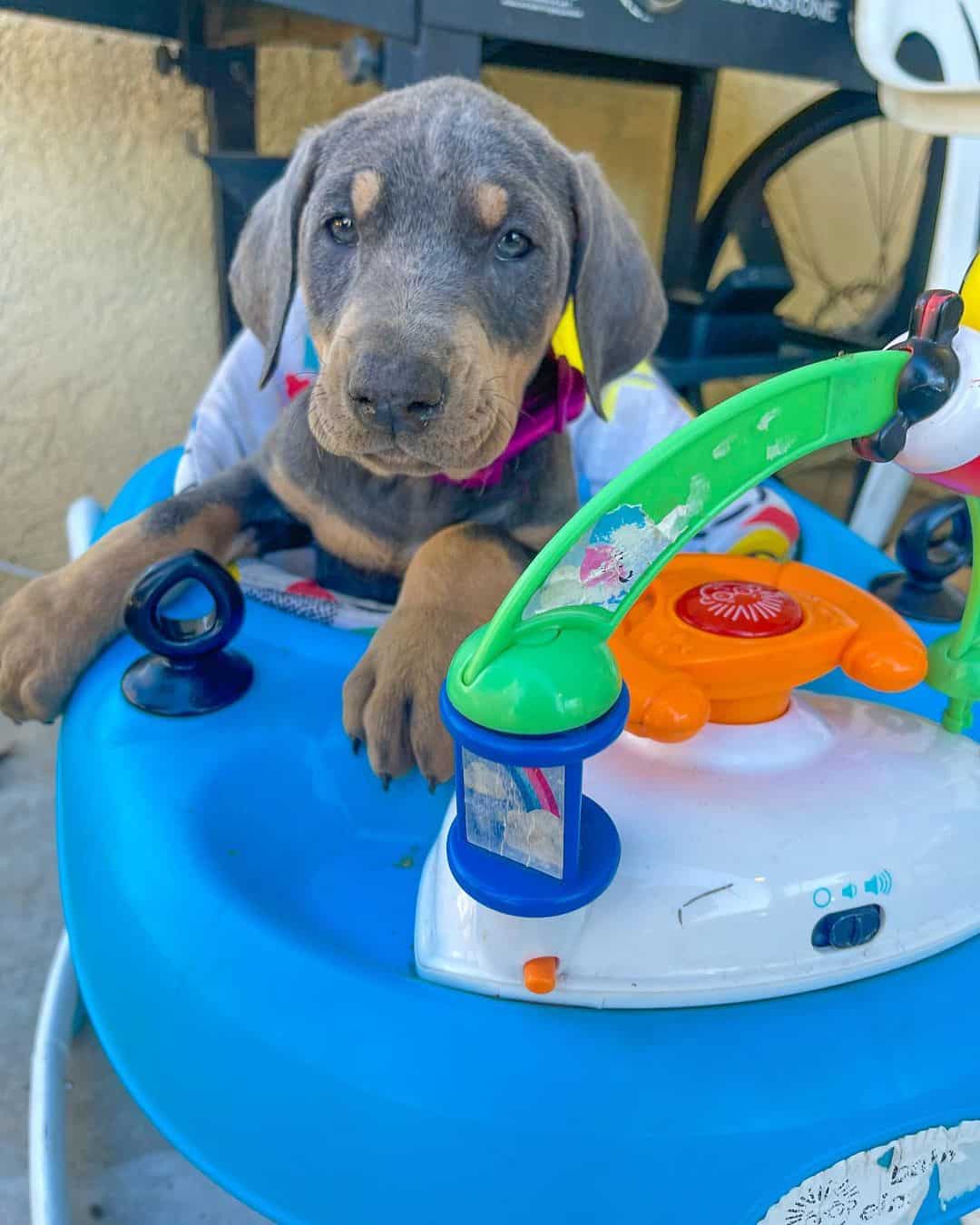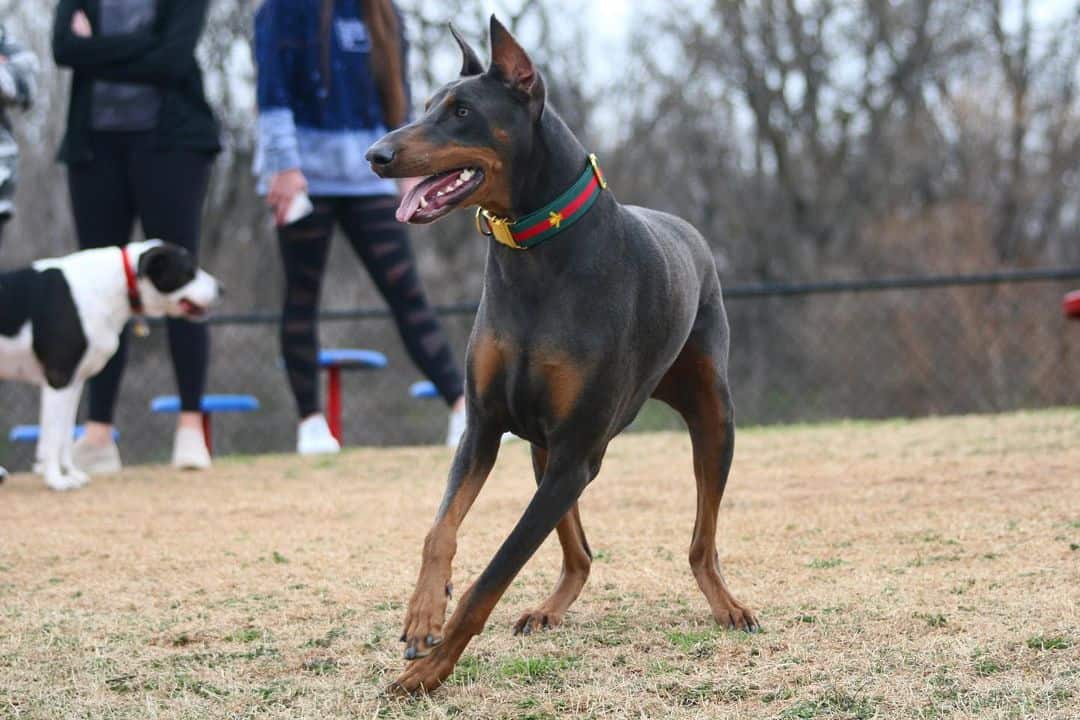When it comes to protection, there are just a few breeds that can compete with a Doberman Pinscher. They are noble-looking and fierce, yet gentle pups that are excellent at their job.
These dogs can come in various coat colors, and one of them happens to be blue. Blue Dobermans, really?
Most of us are familiar with the standard black and tan Dobermans, so this unusual-looking dog is bound to spark your interest. What’s true and what’s not — it’s time to find out.
#1 Blue Dobermans Are Not, In Fact, Blue

If you immediately thought of sky-blue Dobermans, well… I hate to break it to you, but they don’t look like that at all.
A blue Doberman Pinscher is simply a coat color variation of the standard black with rust markings. This blue color is the result of a recessive color dilution gene, which causes dilution (lightening) of the standard coat color, making them less pigmented and appearing bluish.
Basically, the color of the puppy is determined by the color genetics of the parents. Each parent carries a certain gene, and in order for a Blue Doberman to come into existence, there should be two copies of the dilution gene. [1]
In reality, these dogs are not blue in the full sense of this word, but rather a kind of gray-colored, which is why many people also refer to them as gray, silver, or even purple Dobermans.
#2 They Were Heavily Discouraged From Breeding

In the past, these dogs were heavily discouraged from breeding. Many Doberman breeders and pros saw blue Dobermans as a mutated version of the Doberman breed, and they believed they were not fit for reproduction.
Sometimes, they would even consider these diluted colors a disqualifying fault in some dog shows.
Unfortunately, some breeders still feel that way; however, today it is generally believed that if good breeding is present, blue Dobermans are not inferior to their black or red cousins.
#3 They Are The CEOs Of The Blue Doberman Syndrome

Blue Doberman Syndrome (or Color Dilution Alopecia) is a major health concern in the blue Doberman breed.
This is a hereditary condition that usually affects dogs with a diluted gene. It affects the hair follicle on the dog’s coat and causes an abnormal distribution of melanin in the hair shaft, which leads to thinning of the hair and patchy hair loss.
According to Miller [2], although this syndrome is also reported in color dilution variants of other breeds, it is respectively prevalent in the blue and fawn Doberman Pinscher with an incidence rate of 57.9% and 89.5%.
Most of the time, puppies start showing some signs of this disease between six weeks and three years of age.
The most common symptoms are thinning of the hair and permanent hair loss, but there are also some other signs, such as brittle hair, dry and flaky skin, itchiness, low energy levels, bacterial infections, and canine acne.
#4 They Are Only Officially Recognized In The USA

Blue Dobermans are not part of the normal breed standard for European Dobermans according to the FCI standards, but in America, they are one of the four standard colors.
According to the American Kennel Club (AKC), the accepted breed standard colors for the Doberman Pinscher breed are black and rust, red and rust, blue, and fawn.
Since the AKC accepts them, these dogs are able to compete in all standard AKC competitions, such as conformation, obedience, agility, and much more.
#5 Blue Dobermans Are Also Protective

Due to their guarding instincts, they are alert and protective pups that will guard those who they consider a family with all their power.
Blue Dobermans are just as strong and protective as their different colored cousins, and they will surely be one of the best guard dogs for your family.
Strong and powerful on the one hand, and friendly and affectionate on the other — the best of both worlds.
#6 Still Your Velcro Baby

Unfortunately, the Doberman Pinscher breed has an ungrateful reputation for being dangerous, but the truth is quite different. They can also be affectionate and trusted family companions with proper training and early socialization.
Sometimes they are even compared to “velcro dogs” due to their habit of making a strong bond with their owner.
Blue Dobbies are also gentle and affectionate with children, and they can make excellent family pets. As a matter of fact, they love their family so much that they often suffer from separation anxiety if you leave them alone for too long.
Related: My Dog Won’t Leave My Side: How To Deal With A Clingy Dog
#7 Blue Dobermans Are Exercise Freaks

Blue Dobermans are highly energetic dogs that need a lot of exercise. Experts recommend at least two hours of daily exercise for this breed to burn off their large amounts of energy.
They enjoy going for walks, to dog parks, on hikes, or simply a playtime session in the yard. Either way, physical activity is absolutely necessary to keep this dog happy and healthy.
If you are not an active person, or this doesn’t fit well into your lifestyle, blue Doberman probably isn’t a good choice for you. They also require a lot of space, so keep this in mind as well.
#8 They’re Smart, Smart

According to the psychologist and dog researcher, Dr. Stanley Coren, and his book The Intelligence of Dogs [3], the Doberman Pinscher breed ranks as the 5th most intelligent dog.
They are very intelligent and adaptable, and easy to train. With their obedient and eager-to-please nature, training should really be a piece of cake. Nonetheless, you need to be firm, assertive, determined, and consistent with your training practice.
It’s important to start with the socialization of your dog as soon as possible as well. Try to get him exposed to different people, animals, children, situations, and noises, so he can get used to them from an early age.
#9 Blue Dobbies Are Not As Rare As You Might Think

According to the Doberman Pinscher Club of America, 8% to 15% of all Dobermans are blue Dobermans. This is only an estimated number, as it is impossible to know exactly how many blue Dobermans are out there.
They are considered to be one of the rarest color variations out there, but it all depends on your location and the selection of breeders.
However, this color is definitely not as rare as the Isabella Doberman or albino Doberman, which are considered to be the rarest of all Doberman colors.
Long Story Short
Blue Dobermans are truly a sight to see. With their beautiful bluish coat color, fierce looks, and powerful structure, they sure do attract the attention of many people.
Although they still sometimes have a bad reputation, these dogs are actually wonderful family pets, loyal, and affectionate.
A great protector on one side, and a loving companion on the other, combined, make a great pet that everyone could only wish for.
Read next: Warlock Doberman: Separating The Facts From The Fantasy
References:
[1] Kendrick, C. (2023). Coat Color Genetics, The Doberman Pinscher Club of America, Retrieved March 24, 2023, from https://dobequest.org/genotype.php
[2] Miller, W.H. (1990). Colour Dilution Alopecia in Doberman Pinschers with Blue or Fawn Coat Colours: A Study on the Incidence and Histopathology of this Disorder, DOI
[3] Coren, S. (1994). The Intelligence of Dogs: Canine Consciousness and Capabilities.
